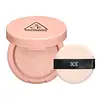What's inside
What's inside
 Key Ingredients
Key Ingredients

 Benefits
Benefits

 Concerns
Concerns

 Ingredients Side-by-side
Ingredients Side-by-side

Dimethicone
EmollientTalc
AbrasiveMica
Cosmetic ColorantTitanium Dioxide
Cosmetic ColorantMethyl Methacrylate Crosspolymer
Diisostearyl Malate
EmollientSynthetic Fluorphlogopite
Phenyl Trimethicone
Skin ConditioningHydrogenated Polydecene
EmollientDimethicone/Vinyl Dimethicone Crosspolymer
Skin ConditioningSilica
Abrasive1,2-Hexanediol
Skin ConditioningGlyceryl Caprylate
EmollientAluminum Hydroxide
EmollientTriethoxycaprylylsilane
Tin Oxide
AbrasiveCI 77491
Cosmetic ColorantCI 19140
Cosmetic ColorantCI 73360
Cosmetic ColorantDimethicone, Talc, Mica, Titanium Dioxide, Methyl Methacrylate Crosspolymer, Diisostearyl Malate, Synthetic Fluorphlogopite, Phenyl Trimethicone, Hydrogenated Polydecene, Dimethicone/Vinyl Dimethicone Crosspolymer, Silica, 1,2-Hexanediol, Glyceryl Caprylate, Aluminum Hydroxide, Triethoxycaprylylsilane, Tin Oxide, CI 77491, CI 19140, CI 73360
Synthetic Fluorphlogopite
Hdi/Trimethylol Hexyllactone Crosspolymer
CI 77891
Cosmetic ColorantMica
Cosmetic ColorantPhenyl Trimethicone
Skin ConditioningSilica
AbrasiveCI 77491
Cosmetic ColorantGlycerin
HumectantMagnesium Aluminum Silicate
Absorbent1,2-Hexanediol
Skin ConditioningCaprylyl Glycol
EmollientGlyceryl Caprylate
EmollientEthylhexylglycerin
Skin ConditioningTin Oxide
AbrasiveWater
Skin ConditioningTocopherol
AntioxidantIngredients Explained
These ingredients are found in both products.
Ingredients higher up in an ingredient list are typically present in a larger amount.
1,2-Hexanediol is a synthetic liquid and another multi-functional powerhouse.
It is a:
- Humectant, drawing moisture into the skin
- Emollient, helping to soften skin
- Solvent, dispersing and stabilizing formulas
- Preservative booster, enhancing the antimicrobial activity of other preservatives
Ci 77491 is also hydrated iron III oxide. It's sole purpose is to give a red/pink hue to products.
Iron III oxides are classified as inorganic chemicals for coloring.
Synthetically created Ci 77491 is considered safer than those naturally found. This is because the synthetically created version may contain less impurities. Iron oxides are generally non-toxic and non-allergenic.
Learn more about CI 77491Glyceryl Caprylate comes from glycerin and caprylic acid, a fatty acid from coconut. It has emollient and emulsifier properties.
As an emollient, it helps hydrate your skin. Emollients work by creating a barrier on your skin to trap moisture in, helping to keep your skin soft and smooth.
On the other hand, emulsifiers prevent ingredients (such as oil and water) from separating.
Learn more about Glyceryl CaprylateMica is a naturally occurring mineral used to add shimmer and color in cosmetics. It can also help improve the texture of a product or give it an opaque, white/silver color.
Serecite is the name for very fine but ragged grains of mica.
This ingredient is often coated with metal oxides like titanium dioxide. Trace amounts of heavy metals may be found in mica, but these metals are not harmful in our personal products.
Mica has been used since prehistoric times throughout the world. Ancient Egyptian, Indian, Greek, Roman, Aztec, and Chinese civilizations have used mica.
Learn more about MicaPhenyl Trimethicone is a silicon-based polymer. It is derived from silica.
Phenyl Trimethicone is used as an emollient and prevents products from foaming.
As an emollient, it helps trap moisture in the skin. It is considered an occlusive.
Learn more about Phenyl TrimethiconeSilica, also known as silicon dioxide, is a naturally occurring mineral. It is used as a fine, spherical, and porous powder in cosmetics.
Though it has exfoliant properties, the function of silica varies depending on the product.
The unique structure of silica enhances the spreadability and adds smoothness, making it a great texture enhancer.
It is also used as an active carrier, emulsifier, and mattifier due to its ability to absorb excess oil.
In some products, tiny microneedles called spicules are made from silica or hydrolyzed sponge. When you rub them in, they lightly polish away dead skin layers and enhance the penetration of active ingredients.
Learn more about SilicaSynthetic Fluorphlogopite is the synthethic version of mica. It consists of fluorine, aluminum and silicate.
Synthetic Fluorphlogopite is used to add volume to products.
It is considered non-irritating on the skin.
Learn more about Synthetic FluorphlogopiteTin Oxide is an inorganic oxide used to add opacity and volume to a product. In nature, it is already found in mineral form. The main ore of tin is an opaque and shiny mineral called casseterite.
Tin Oxide helps remove translucency in a product, or make it more opaque. Besides adding opacity, tin oxide is used for bulking to add volume.